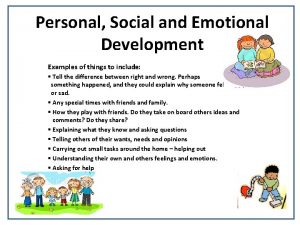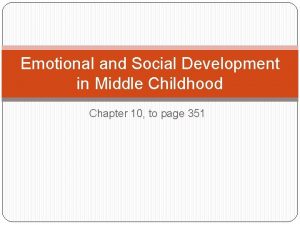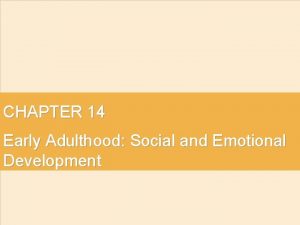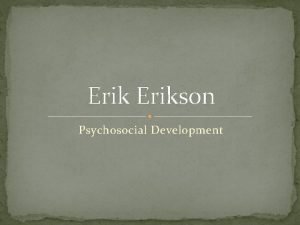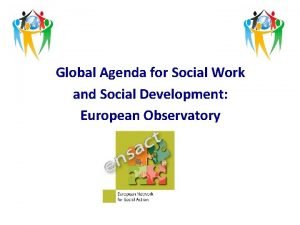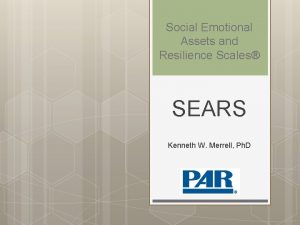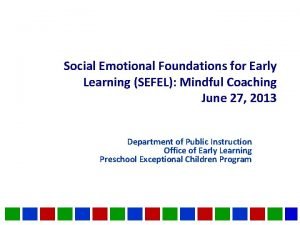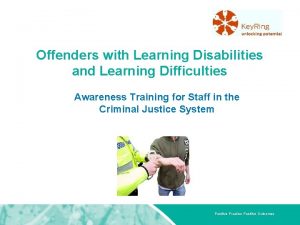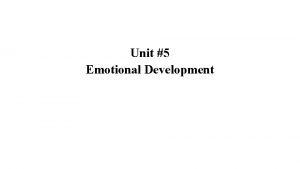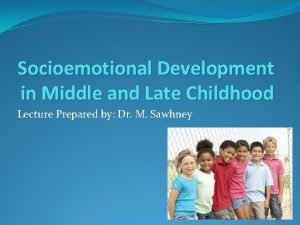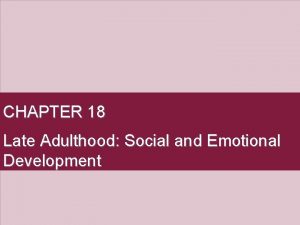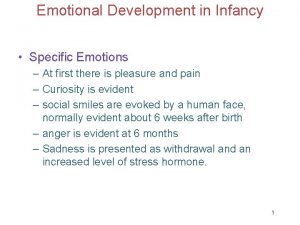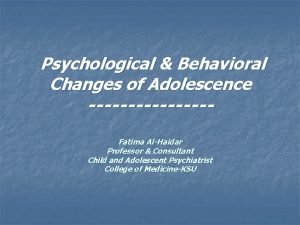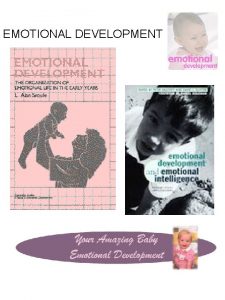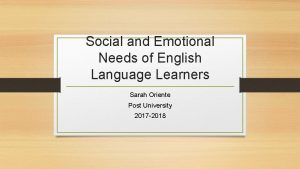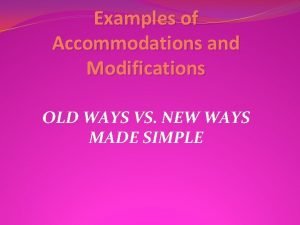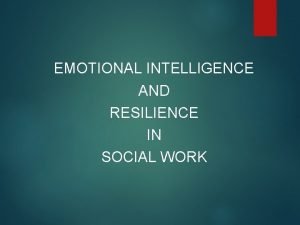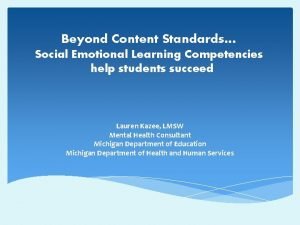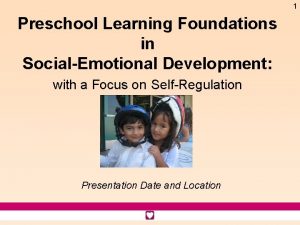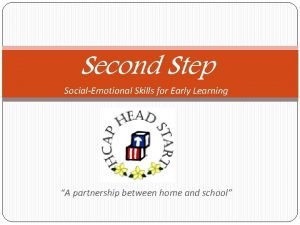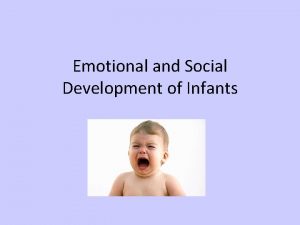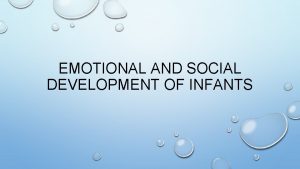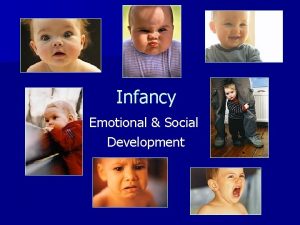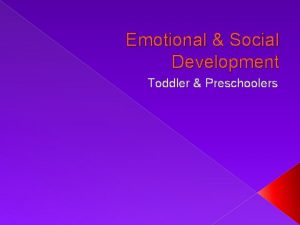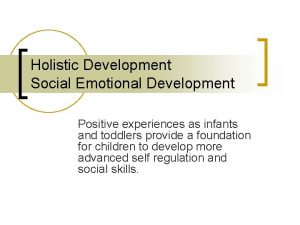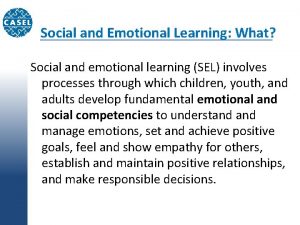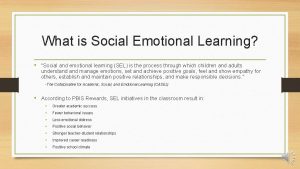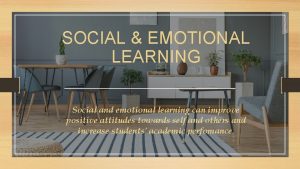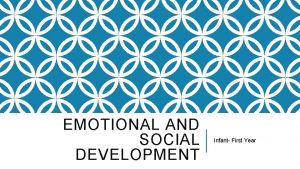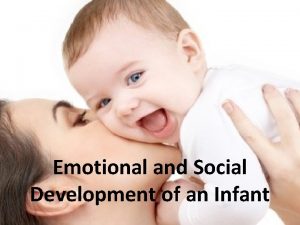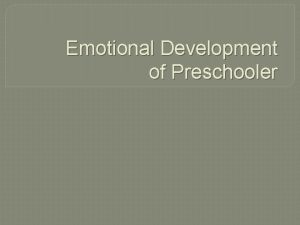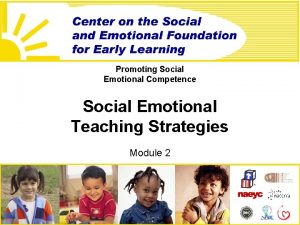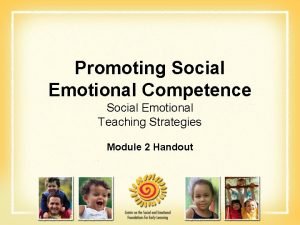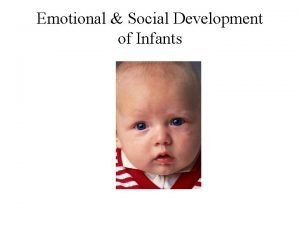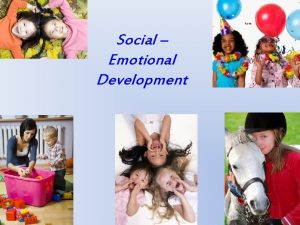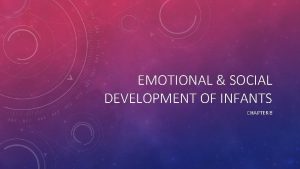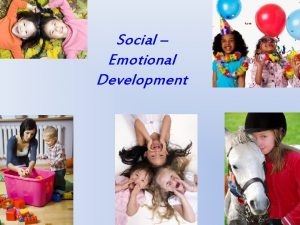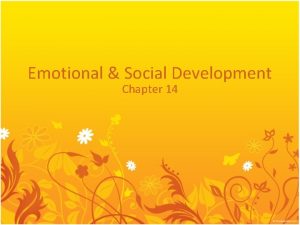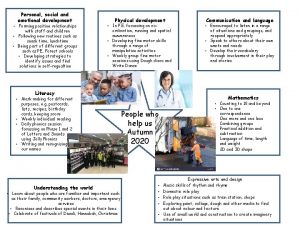Positive Social and Emotional Development How to Target


































- Slides: 34

Positive Social and Emotional Development: How to Target Through Reading Ivette Cejas, Ph. D Department of Otolaryngology University Of Miami

Who am I?

Learning Objectives • Discuss social and emotional milestones for young children • Identify ways reading and social/emotional intelligence are related • Discuss strategies to foster social and emotional development

Social & Emotional Wellbeing • What do you consider social and emotional wellbeing? • What are some characteristics?


Preschool 3 Years • Takes turns in games • Shows a wide range of emotions • May get upset with major changes in routine • Separates easily from parents • Shows affection for friends without prompting 4 Years • Enjoys doing new things • More creative with makebelieve play • Would rather play with other children than by himself • Cooperates with other children • Often can’t tell what’s real and what’s make-believe • Talks about what they like Milestones are from CDC. gov

Early Childhood 5 Years • More likely to agree with rules • Likes to sing, dance, and act • Is aware of gender • Can tell what’s real and what’s make-believe • Shows more independence • Is sometimes demanding and sometimes very cooperative • Wants to be like friends 6 -8 years old • Shows more independence from parents and family • Starts to think about the future • Understands more about his/her place in the world • Pays more attention to friendships and teamwork • Wants to be liked and accepted by friends Milestones are from CDC. gov

Child Development

Impact on Relationships • Relationships are developed through the emotional bond between the child and the primary caregiver. It is through this relationship we learn to: – Regulate emotions- “self soothe” – Develop trust in others – Freely explore our environment – Understand ourselves and others – Understand that we can impact the world around us Coles, E. K. Building Social Emotional and Behavioral Competencies in the Elementary Setting Using a Multi-Tired System of Supports


Social & Emotional Learning • Process through which children and adults understand manage emotions • Set and achieve positive goals • Feel and show empathy for others, • Establish and maintain positive relationships, • Make responsible decisions (casel. org/what-is-sel/)

Social & Emotional Development Links to Reading • A meta-analysis of 213 SEL programs found that students who participated in these programs had an 11 percentile point gain in achievement (Durlak, Weissber, Dymnicki, Taylor & Schellinger, 2011) – Primary measures of achievement were reading and math • Another recent meta-analysis found that SEL interventions on reading positively effected reading performance (ES= +0. 25) (Corcoran, Cheung, Kim, Xie, 2018)

How to Foster Social and Emotional Development during Storytelling

Respectful and Responsive Relationships “Responsive relationships truly make up the hear of what you do in your work with young children and families. For infants and toddlers, all learning happened in the context of their relationships with the important adults in their lives”. -National Center on Early Childhood Development, Teaching, and Learning (n. d. , p. 1)

Strategies to Make Reading Fun • Shared book reading • Read books that relate to child’s interests • Act out stories (encourages comprehension) • Reread books

Encourage Social-Emotional Development Through Reading • Read books with social-emotional content – Jabari Jumps by Gaia Cornwall § Recommended for ages 4 -8 – Too Shy for Show and Tell by Beth Bracken § Recommended for ages 4 -6 – Enemy Pie by Derek Munson § Recommended for ages 5 -8 – Last Stop on Market Street by Matt de la Peña § Recommended for ages 3 -5 – We’re All Wonders by R. J Palacio § Recommended for ages 4 -8

Encourage Social-Emotional Development Through Reading • Connect child’s experience with what happens in the book – Example: If the book talks about the first day of school, ask child “how did you feel on your first day of school? ” • Ask child what they think the book character was feeling • Read in small groups and encourage children to interact with each other


Modeling • • Get down to the child’s level Make eye contact Smile Show you are interested by commenting on what they are doing

Labeled Praise • Praise increases the behavior • Define problem behaviors. Define the opposite behavior and then praise it. – Problem Behavior- child whines – Opposite Behaviors- talks with indoor voice, talks nicely, asks nicely, patient, quiet • Be genuine • Do not take appropriate behavior for granted

What can you do if a child displays social and emotional challenges?

Tucker the Turtle To download full Tucker Turtle Story go to : https: //iod. unh. edu/sites/default/files/media/Project_Page_Resources/PBIS/a 5_handout_tucker-turtle-takestime_muscott. pdf

Flower/Candle Technique

More Coping Strategies • Guided Imagery – Close your eyes and think of your favorite activity or favorite place • Positive Self Talk – Think to yourself over and over, “I am okay; I feel calm. ” • Use a relaxation script • Distraction – Go for a walk – Have a drink of water – Listening to music – Sing – Plan a fun activity – Watch TV – Blow up a balloon – Have a lollipop – Write a letter – Draw

Improving Self-Esteem • Focus on strengths • Don’t draw comparisons • Give children choices • Let child do certain tasks by themselves

Social Stories

Formal SEL Programs • • I Can Problem Solve Positive Action Resolving Conflict Creatively Program RULER Approach

I Can Problem Solve




Why should we be reading aloud to children? https: //youtu. be/ZBu. T 2 wd. Ytp. M

Questions/ Discussion

THANK icejas@med. miami. edu
 Fictional character names
Fictional character names Middle childhood social and emotional development
Middle childhood social and emotional development Social development middle adulthood
Social development middle adulthood Emotional development for early adulthood
Emotional development for early adulthood Emotional development in late adulthood
Emotional development in late adulthood Social emotional development erikson
Social emotional development erikson Primary target market and secondary target market
Primary target market and secondary target market Global agenda for social work and social development
Global agenda for social work and social development Late childhood
Late childhood Social development in middle adulthood
Social development in middle adulthood Sears assessment
Sears assessment Social and emotional wellbeing framework
Social and emotional wellbeing framework Social and emotional foundations for early learning
Social and emotional foundations for early learning Novobiocin test
Novobiocin test Negative numbers rules
Negative numbers rules Positive practice positive outcomes
Positive practice positive outcomes Define emotional development.
Define emotional development. Middle & late childhood
Middle & late childhood Early adulthood developmental stage
Early adulthood developmental stage Robert peck's three developmental tasks
Robert peck's three developmental tasks Emotional development in late adulthood
Emotional development in late adulthood Emotional development in infancy
Emotional development in infancy Chapter 8:1 life stages
Chapter 8:1 life stages What is emotional development
What is emotional development Emotional development in adolescence
Emotional development in adolescence Conclusion of emotional development
Conclusion of emotional development Social thinking and social influence in psychology
Social thinking and social influence in psychology Social thinking social influence social relations
Social thinking social influence social relations Social emotional needs of ell students
Social emotional needs of ell students Social emotional present level of performance examples
Social emotional present level of performance examples Emotional intelligence in social work
Emotional intelligence in social work Social emotional learning standards michigan
Social emotional learning standards michigan Preschool learning foundations volume 1
Preschool learning foundations volume 1 Second step social emotional skills for early learning
Second step social emotional skills for early learning Social emotional learning standards nj
Social emotional learning standards nj
